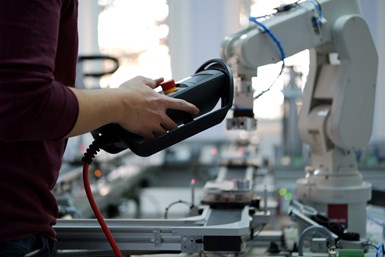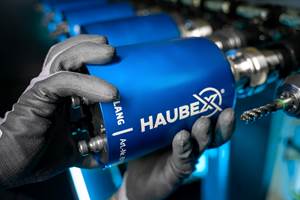Overcoming Barriers to Machine Shop Automation
Industrial automation using robots has improved productivity for operations large and small — so why do some manufacturers shy away from it?
Share





Hwacheon Machinery America, Inc.
Featured Content
View More
ECi Software Solutions, Inc.
Featured Content
View More


.png;maxWidth=45)
DMG MORI - Cincinnati
Featured Content
View MoreI have been a great advocate of industrial automation, including robots, for years. I have always seen this technology as the key to being competitive in the marketplace. Over the years, I have become more and more frustrated that many organizations are not embracing automation and robotics technologies. In machine shops, the resistance seems especially high. When I ask shops about their resistance, I often get the same answer: Automation does not fit into our processes.
While manufacturers have good reasons for implementing the processes they do, my natural response to this is, “then change your processes.”
There are a few barriers to automation that I believe lead people in the industry to keep this mindset. Firstly, robotics are not as effective when we expect them to exactly imitate human motion. Thinking of robotics in terms of human motion is a natural tendency, especially with Hollywood portraying robots as indistinguishable from humans. Maybe down the road, that will become reality, but for now we must plan our processes around the actual strengths and capabilities of robots.
One main advantage of robots is that they can repeat the same movements continuously without fail. They also won’t slow down during the day and don’t require breaks. This is their strength. We therefore have to plan their movements ahead of time and according to their strengths, not the strengths of human workers.
Another difficulty of embracing automation lies in the variability of material sizes used on the shop floor. Robots are very productive when using a common size of material, but machine shops often need to use differently sized materials to minimize the amount of machining. This leads to high variability in raw material sizes. Constant changeover on robots and fixtures due to material variability is not very productive, and can slow down processes — the opposite of what we want in an automation solution.
To overcome this, it’s ideal to make parts out of similar material sizes, of course. If that’s not possible, batching parts that are made with the same size of material is helpful. In my experience, on smaller items, the material cost is not typically as important as throughput. Throughput reduction causes bigger cost savings and therefore higher profits then the cost savings that come from minimizing the material size. Strategies for using the same material for various items help give longer run volumes and therefore robots can be more easily integrated. Using a common size of material leads to greater productivity with automation.
Finally, robots are very effective in situations where common fixtures are used to hold parts. Often, shops use many different fixtures to hold various sizes of material — unfortunately, this does not play to the strength of robots. This is a great point at which to rethink processes. To simplify automation integration, the objective is to load common piece of material onto a common fixture. Manufacturers should consider finding a fixture that will hold numerous parts done repeatably.
I realize that coming up with strategies will take time and effort, but they enable large operations and smaller job shops alike to be competitive into the future. Automation and robotics are also key to addressing the shortage of skilled worker. We can sit here and complain that we cannot find enough workers or we can implement a strategy to help our current and future workers become more productive and competitive.
The first step to implementing robots and automation is saying “yes” and embracing the change, adjusting processes as necessary. Many companies are doing this with success. Denying the potential of automation is like sticking your head in the sand. The world will continue to move around you and you will be left further behind.
The point of using automation is to make production simpler and more repeatable. It is about saving labor and being more productive. It is about giving employees tools and strategies to compete at a higher level. I truly believe that automation and robotics will be the standard in machine shops in the near future, and I already see this on the horizon.
I am hoping that machine shop owners find the courage to implement robotics and automation because it brings a much brighter future companies and its employees. That is how I see it from the shop floor!
Related Content
Using the Toolchanger to Automate Production
Taking advantage of a feature that’s already on the machine tool, Lang’s Haubex system uses the toolchanger to move and store parts, making it an easy-to-use and cost-effective automation solution.
Read MoreCNC Machine Shop Honored for Automation, Machine Monitoring
From cobots to machine monitoring, this Top Shop honoree shows that machining technology is about more than the machine tool.
Read MoreHow to Accelerate Robotic Deburring & Automated Material Removal
Pairing automation with air-driven motors that push cutting tool speeds up to 65,000 RPM with no duty cycle can dramatically improve throughput and improve finishing.
Read MoreSame Headcount, Double the Sales: Successful Job Shop Automation
Doubling sales requires more than just robots. Pro Products’ staff works in tandem with robots, performing inspection and other value-added activities.
Read MoreRead Next
5 Rules of Thumb for Buying CNC Machine Tools
Use these tips to carefully plan your machine tool purchases and to avoid regretting your decision later.
Read MoreBuilding Out a Foundation for Student Machinists
Autodesk and Haas have teamed up to produce an introductory course for students that covers the basics of CAD, CAM and CNC while providing them with a portfolio part.
Read MoreRegistration Now Open for the Precision Machining Technology Show (PMTS) 2025
The precision machining industry’s premier event returns to Cleveland, OH, April 1-3.
Read More











































